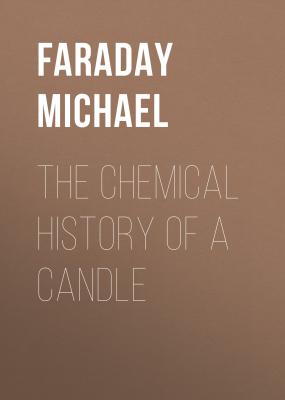The Chemical History of a Candle. Faraday Michael
Читать онлайн.| Название | The Chemical History of a Candle |
|---|---|
| Автор произведения | Faraday Michael |
| Жанр | Химия |
| Серия | |
| Издательство | Химия |
| Год выпуска | 0 |
| isbn |
Is it not beautiful to think that such a process is going on, and that such a dirty thing as charcoal can become so incandescent? You see it comes to this—that all bright flames contain these solid particles; all things that burn and produce solid particles, either during the time they are burning, as in the candle, or immediately after being burnt, as in the case of the gunpowder and iron-filings,—all these things give us this glorious and beautiful light.
I will give you a few illustrations. Here is a piece of phosphorus, which burns with a bright flame. Very well; we may now conclude that phosphorus will produce, either at the moment that it is burning or afterwards, these solid particles. Here is the phosphorus lighted, and I cover it over with this glass for the purpose of keeping in what is produced. What is all that smoke? That smoke consists of those very particles which are produced by the combustion of the phosphorus. Here, again, are two substances. This is chlorate of potassa, and this other sulphuret of antimony. I shall mix these together a little, and then they may be burnt in many ways. I shall touch them with a drop of sulphuric acid, for the purpose of giving you an illustration of chemical action, and they will instantly burn9. [The Lecturer then ignited the mixture by means of sulphuric acid.] Now, from the appearance of things, you can judge for yourselves whether they produce solid matter in burning. I have given you the train of reasoning which will enable you to say whether they do or do not; for what is this bright flame but the solid particles passing off?
Mr. Anderson has in the furnace a very hot crucible,—I am about to throw into it some zinc filings, and they will burn with a flame like gunpowder. I make this experiment because you can make it well at home. Now, I want you to see what will be the result of the combustion of this zinc. Here it is burning—burning beautifully like a candle, I may say. But what is all that smoke, and what are those little clouds of wool which will come to you if you cannot come to them, and make themselves sensible to you in the form of the old philosophic wool, as it was called? We shall have left in that crucible, also, a quantity of this woolly matter. But I will take a piece of this same zinc and make an experiment a little more closely at home, as it were. You will have here the same thing happening. Here is the piece of zinc, there [pointing to a jet of hydrogen] is the furnace, and we will set to work and try and burn the metal. It glows, you see: there is the combustion, and there is the white substance into which it burns. And so, if I take that flame of hydrogen as the representative of a candle, and shew you a substance like zinc burning in the flame, you will see that it was merely during the action of combustion that this substance glowed—while it was kept hot; and if I take a flame of hydrogen, and put this white substance from the zinc into it, look how beautifully it glows, and just because it is a solid substance.
I will now take such a flame as I had a moment since, and set free from it the particles of carbon. Here is some camphine, which will burn with a smoke; but if I send these particles of smoke through this pipe into the hydrogen flame, you will see they will burn and become luminous, because we heat them a second time. There they are. Those are the particles of carbon re-ignited a second time. They are those particles which you can easily see by holding a piece of paper behind them, and which, whilst they are in the flame, are ignited by the heat produced, and, when so ignited, produce this brightness. When the particles are not separated, you get no brightness. The flame of coal-gas owes its brightness to the separation, during combustion, of these particles of carbon, which are equally in that as in a candle. I can very quickly alter that arrangement. Here, for instance, is a bright flame of gas. Supposing I add so much air to the flame as to cause it all to burn before those particles are set free, I shall not have this brightness; and I can do that in this way:—If I place over the jet this wire-gauze cap, as you see, and then light the gas over it, it burns with a non-luminous flame, owing to its having plenty of air mixed with it before it burns; and if I raise the gauze, you see it does not burn below10
Конец ознакомительного фрагмента.
Текст предоставлен ООО «ЛитРес».
Прочитайте эту книгу целиком, купив полную легальную версию на ЛитРес.
Безопасно оплатить книгу можно банковской картой Visa, MasterCard, Maestro, со счета мобильного телефона, с платежного терминала, в салоне МТС или Связной, через PayPal, WebMoney, Яндекс.Деньги, QIWI Кошелек, бонусными картами или другим удобным Вам способом.
